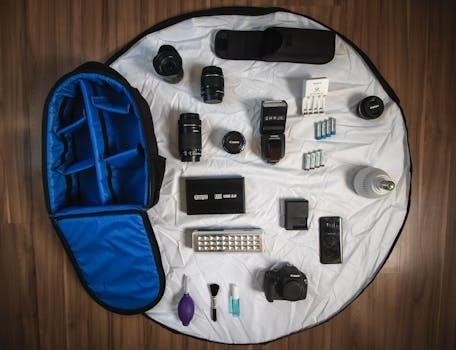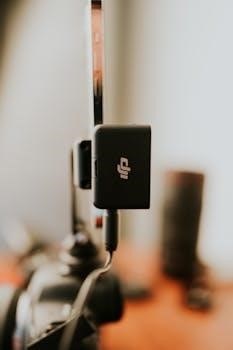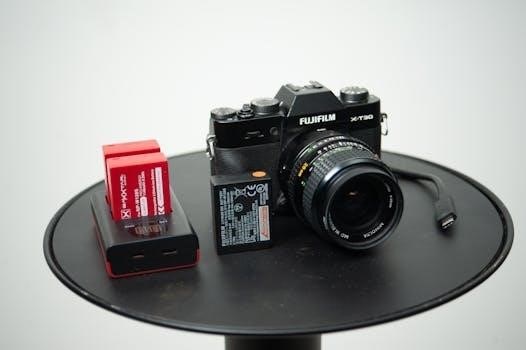Dododuck USB Charger Recorder Manual⁚ An Overview
This manual provides a comprehensive guide to using your Dododuck USB charger recorder. It covers charging methods, accessing files, troubleshooting, and understanding various models for optimal performance, and long-term device maintenance.

Understanding Dododuck Recorder Models
Dododuck offers diverse recorder models tailored for various needs, from voice-activated recording to extended battery life. Each model has specific features, impacting recording capacity, audio quality, and overall ease of use for different scenarios.
Common Models⁚ Q37, Q78, Q1, Q63
The Dododuck Q37 is a mini voice-activated recorder known for its compact design and 30-day standby recording capability. The Q78 offers professional-grade recording with enhanced features and a longer battery life. The Q1 stands out for its simplicity and ease of use, making it ideal for beginners.
Lastly, the Q63 balances portability and functionality, providing a versatile recording solution for various situations. These models offer a range of features, including voice activation, extended recording times, and different storage capacities. Each model caters to specific user needs, ensuring there’s a Dododuck recorder for every application. Understanding the nuances of each model is crucial for selecting the device that best fits your requirements.
Charging Your Dododuck Recorder
Proper charging is essential for optimal performance. This section outlines the different methods for charging your Dododuck recorder, including USB and power adapter options, as well as indicators for a full charge.
USB Charging Method
The USB charging method is a convenient way to power your Dododuck recorder. Connect the included USB data cable to your recorder and then to a computer’s USB port. Ensure the computer is powered on. Alternatively, you can use a USB wall adapter with an output of 1A or less.
During charging, a red light will typically flash, indicating that the device is receiving power. A blue light will appear once the device is fully charged, signaling that you can disconnect it. Charging time may vary depending on the model and the power source used. It’s important to use the provided USB cable or a compatible one to avoid any damage to the device. Regular USB charging helps maintain battery health and ensures your recorder is always ready for use. Avoid using high-powered chargers as they might harm the battery.
Power Adapter Charging
To charge your Dododuck recorder using a power adapter, connect the included USB data cable to the recorder and then plug it into a USB power adapter. Ensure that the power adapter is compatible with the recorder’s voltage and current requirements, typically 5V/1A. Plug the adapter into a standard wall outlet.
While charging, a red light will usually flash, indicating the device is receiving power. Once the device is fully charged, a blue light will appear. Disconnect the recorder from the power adapter once it’s fully charged to prevent overcharging, which can reduce battery life. Avoid using power adapters with higher amperage than recommended, as this can damage the device’s battery. Always use a reliable power source to ensure safe and efficient charging. Regularly check the cable and adapter for any signs of damage.
Charging Indicators⁚ Red and Blue Lights
Dododuck recorders typically use a combination of red and blue lights to indicate the charging status of the device. When the recorder is connected to a power source and charging, a red light will usually flash continuously. This indicates that the battery is currently being charged.
Once the charging process is complete, the red light will be replaced by a solid blue light. This signifies that the battery is fully charged and ready for use. It is important to disconnect the recorder from the power source once the blue light appears to avoid overcharging, which can reduce the overall lifespan of the battery. If no light appears when connected, check the cable and power source.

Accessing the User Manual
Find the Dododuck recorder user manual through online resources, often including video guides, for easy understanding. These resources offer detailed instructions and troubleshooting tips for optimal use.
Online Resources and Video Manuals
Dododuck provides several online resources to access the user manual for their USB charger recorders. These resources include downloadable manuals in PDF format, often found on the official Dododuck website or product pages on retailer sites like Amazon and Walmart. Additionally, simplified video manuals are available, offering visual guidance on the main features of models like the Q37.
These videos demonstrate charging procedures, accessing recording files, and utilizing voice-activated recording features. Customers can find these video manuals in the “Customer questions & answers” section on product listings. Furthermore, some user manuals, like the Q1 16GB instructions, can be directly downloaded.
These online resources ensure users can quickly learn how to operate and troubleshoot their Dododuck recorder effectively.
Connecting to a Computer via USB
To connect your Dododuck recorder, use the provided USB cable. This allows you to access recording files stored on the device, treating it like a standard USB drive for easy file management.
Accessing Recording Files
After connecting your Dododuck recorder to your computer using the USB cable, the device should appear as a removable drive. Navigate to this drive to find your recording files. Typically, recordings are stored in a folder labeled “RECORD.” Open this folder to view a list of your audio files.
Ensure the recorder is turned off before connecting to prevent data corruption. Once connected, you can copy, move, or delete files as needed. For optimal organization, consider creating subfolders for different recording sessions or topics. Always safely eject the device from your computer before disconnecting the USB cable to avoid data loss. If you encounter difficulties, consult the troubleshooting section of this manual or the video manual for assistance. The video manual explains accessing Dododuck Q37 files. Make sure the USB is properly connected.

Troubleshooting Common Issues
Experiencing difficulties with your Dododuck recorder? This section addresses common problems. If the device fails to power on, ensure it is adequately charged. Connect it to a power source via USB and allow it to charge for at least two hours. If recording quality is poor, check the microphone for obstructions.
For issues with file access, verify the USB connection and try a different port. If the device is unresponsive, try resetting it by holding the power button for ten seconds. If time stamps are incorrect, use the “time.exe” tool to synchronize the device’s clock with your computer. If problems persist, consult the online resources or contact customer support for assistance. For the Q37 model, refer to the video manual for specific troubleshooting steps. Remember to safely eject the device after use.

Dododuck Accessories
Enhance your Dododuck recorder with accessories like headset adapters for Q58/Q78 models, and Micro USB adapters for devices like Q1, Q37, Q61, and Q77, for expanded functionality and optimized user experience.
Headset Adapters and Micro USB Adapters
Dododuck offers a range of accessories to enhance the functionality of your voice recorder. Headset adapters, such as those compatible with the Q58 and Q78 recorders, enable convenient audio monitoring during recording. These adapters often feature simple USB-C connections and do not require batteries, ensuring ease of use and portability.
Micro USB adapters extend compatibility to various models like the Q1, Q37, Q61, and Q77. These adapters facilitate seamless connectivity for charging and data transfer. By utilizing these accessories, users can maximize the potential of their Dododuck voice recorders, adapting them to diverse recording scenarios and personal preferences. Proper use of these accessories ensures optimal performance and longevity of the recording device.
Selecting the appropriate adapter is crucial for a smooth user experience.